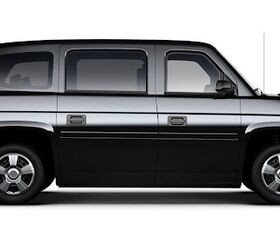The North American market for handicap accessible vehicles was traditionally served by aftermarket conversions of standard passenger vans. However, the early 2000s saw a spark of innovation with entrepreneurs envisioning vehicles designed from the ground up for accessibility. This is the story of the Vehicle Production Group (VPG) and their ambitious, yet ultimately ill-fated, MV-1 car – a vehicle that aimed to revolutionize accessible transportation.
Vehicle Production Group LLC (VPG) was established in 2006 in Miami, Florida, by Marc Klein and Patton Corrigan. Fueled by personal investments and venture capital from Three Seasons Capital, VPG quickly assembled a team of engineers and managers to bring their accessible vehicle concept to life. Initially, VPG optimistically projected a 2008 launch for their vehicle. However, this timeline soon shifted to 2010, hinting at the challenges that lay ahead for the nascent automaker.
VPG’s initial design was presented as the “Standard Taxi,” making its debut at the North American International Auto Show (NAIAS) in Detroit in September 2006. Around the same period, the Standard Taxi was proposed as a contender in New York City Mayor Michael Bloomberg’s initiative to replace 90% of the city’s taxi fleet with low-emission vehicles by 2030. The New York Design Trust for Public Space spearheaded this project, inviting low-emission taxi designs from private companies. VPG submitted their proposal, likely including a CD-ROM of information. Following its NAIAS unveiling, the Standard Taxi was showcased at the Taxicab, Limousine, and Paratransit Association conference in Las Vegas. The vehicle was designed with full compliance with the Americans with Disabilities Act (ADA), featuring an integrated, automatically extending ramp for easy wheelchair and mobility scooter access.
As VPG sought a manufacturing partner for the Standard Taxi, the initial production target date passed. In mid-2008, VPG announced a significant production agreement with AM General in South Bend, Indiana. AM General, renowned for building military vehicles like the Humvee and the civilian Hummer H2, would not only manufacture the Standard Taxi in Mishawaka, Indiana, but also collaborate as a development partner.
Technical specifications released at the time detailed the Standard Taxi’s robust body-on-frame construction and rear-wheel-drive configuration. It was built upon a GM truck chassis and powered by a 4.3-liter Vortec V6 engine from the GMT900 pickup truck series. The prototype featured a 122-inch wheelbase, an overall length of 196.5 inches, a width of 79.4 inches, and a height of 75 inches.
Financial backing for VPG grew alongside development and the secured production deal. In August 2008, the company announced $160 million in equity financing through Perseus, an equity fund management firm. VPG also cultivated a strong relationship with Powertrain Integration LLC, which had access to GM engines and received partial funding from General Motors. Furthermore, Clean Energy Fuels Corporation (CEFC), founded by T. Boone Pickens, pledged support for the CNG version of the Standard Taxi and its marketing. Both Pickens and General Motors made direct cash investments in VPG.
Another major boost for VPG arrived in late 2008 when they secured a marketing partnership with MV Transportation, the largest privately-owned transportation contracting company in the US and the leading provider of paratransit services. VPG also planned for Canadian distribution, partnering with The Motion Group of Companies to sell the Standard Taxi to commercial and municipal fleets in Canada.
As the revised 2010 production date approached, VPG actively sought feedback on its vehicle from both consumers and commercial operators. These insights led to significant design refinements focused on practicality and user-friendliness. VPG deemed these changes substantial enough to warrant a new name. The Standard Taxi was reborn as the MV-1, short for Mobility Vehicle 1, signaling its primary purpose. While the MV-1 showed great promise, VPG required further funding and approached the Department of Energy (DOE) in early 2011. The DOE recognized the MV-1’s potential and approved a $50 million loan, which VPG promptly utilized.
Production of the MV-1 finally commenced in October 2011. VPG had achieved a significant milestone: the first purpose-built accessibility vehicle manufactured in North America. The MV-1’s specifications were slightly refined from the Standard Taxi prototype. The wheelbase was shortened to 118 inches, while length, width, and height remained consistent. The GMT chassis was replaced with a custom chassis developed by Roush, based on the Ford Panther platform. The engine was also sourced from the Panther platform – the familiar Ford Modular 4.6-liter V8, converted to run on compressed natural gas (CNG) with assistance from Clean Energy Fuels Corporation. Gasoline versions were also offered, though they were not low-emissions vehicles. The CNG variant boasted an estimated range of 290 miles. The transmission was a four-speed automatic unit from the Ford Crown Victoria.
The MV-1’s interior was remarkably spacious for its exterior dimensions, accommodating six adults, including two in full-size wheelchairs. Its electric ramp could handle up to 1,200 pounds and retracted seamlessly beneath the vehicle floor. This ramp was supplied by ASC, a company with a history in sunroof manufacturing. The rear doors were designed with a generous 36-inch width and 56-inch height for easy wheelchair ingress and egress. The MV-1 had a curb weight of 6,600 pounds and was offered in base SE, mid-level DX, luxury LX (introduced after 2012), and Commercial trim levels.
The first MV-1 rolled off the assembly line in the fall of 2011 and was presented to Marc Buoniconti, a disabled former football player and VPG spokesperson who had sustained a spinal injury during college. On October 21, 2011, the New York Taxi and Limousine Commission approved the MV-1 as a yellow cab. This was a landmark achievement, marking the MV-1 as the first purpose-built taxi authorized for NYC taxi service since the iconic Checker Marathon. With production underway and New York City as a key customer, VPG’s future appeared bright. However, this optimism was short-lived.
In the summer of 2012, after approximately seven months of production, VPG temporarily halted assembly to retool for the upscale LX trim of the MV-1. The LX trim, aimed at livery and private use, featured remote control operation of the side ramp and a more luxurious interior with wood trim. Unfortunately, restarting production after this pause proved challenging.
By February 2013, VPG defaulted on its DOE loan, violating minimum finance clauses in the loan agreement. Production ceased entirely that month. By May, VPG had laid off all employees and shut down operations. The government was left with an unpaid loan, but AM General saw an opportunity. In September 2013, AM General approached the DOE to acquire VPG’s assets, offering to purchase the $50 million loan for a mere $3 million. The DOE accepted, writing off the remaining debt and transferring the assets to AM General.
Following this acquisition, AM General established Mobility Ventures as a wholly-owned subsidiary to manufacture and market the MV-1 through AM General’s dealer network. On March 11, 2014, AM General restarted MV-1 production in Mishawaka, Indiana, continuing the legacy of the vehicle they had helped develop.
AM General initially made no changes to the MV-1. However, model year updates brought necessary improvements. For the 2015 and 2016 models, the powertrain was upgraded to a more modern Ford 3.7-liter V6 engine paired with a six-speed automatic transmission, similar to the base Ford Explorer. AM General managed to sell around 2,000 MV-1 units annually. Interestingly, these vehicles were assembled on the same Indiana production line as the Mercedes-Benz R-Class for the Chinese market.
The Mishawaka plant’s work on the R-Class attracted the attention of overseas investors. SF Motors, a Silicon Valley-based company backed by Chinese investors, made AM General an offer for the Mishawaka plant that was too good to refuse. This timing was opportune as R-Class production was nearing its end in 2017. When the factory changed ownership in 2016, both MV-1 and R-Class production stopped. SF Motors announced plans to retool the factory for EV production, and while they maintain a website under the name SERES, concrete progress beyond CGI renderings remains unseen.
For those intrigued by this piece of automotive history, a used MV-1 is currently listed for sale in Virginia. While not the luxurious LX trim, it represents a unique vehicle – possibly the only factory-produced car combining a utilitarian commercial interior with a Lincoln steering wheel.

